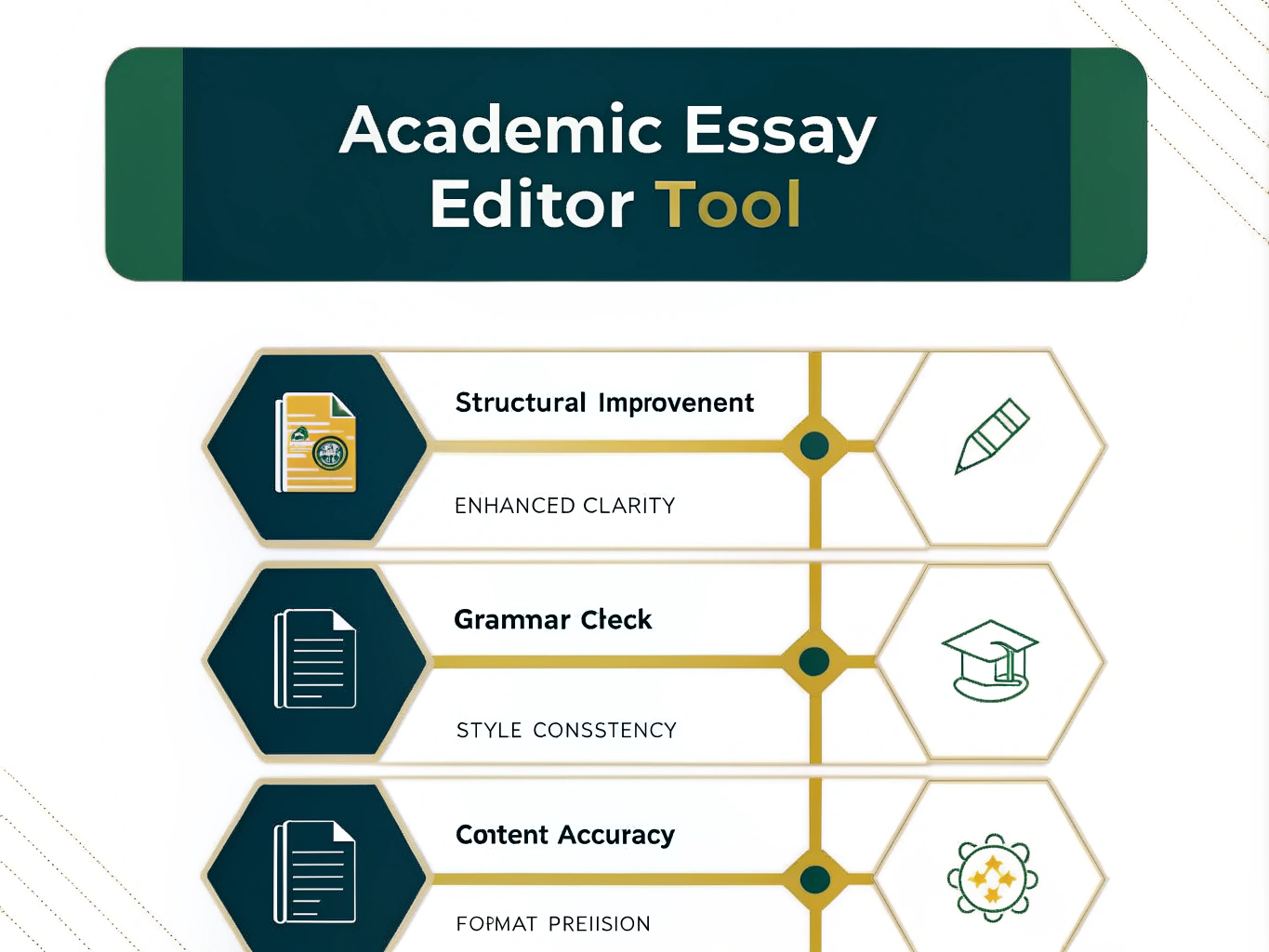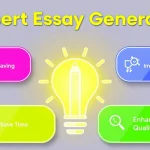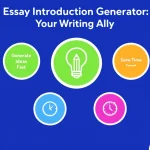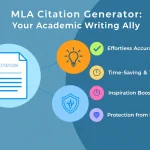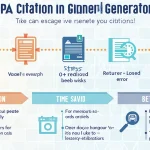Essay and Literature Review Editor
Is this tool helpful?
How to Use the Academic Essay Editor Tool Effectively
To make the most of our Academic Essay Editor Tool, follow these simple steps:
- Select Document Type: Begin by specifying the type of document you’re working on. For example, you might enter “Argumentative Essay” or “Comparative Literature Review.”
- Paste Your Text: Copy and paste the full text of your document into the provided text area. Ensure you include all sections, from introduction to conclusion.
- Specify Style Guide: Enter the style guide you’re following. Common options include “APA 7th Edition” or “MLA 9th Edition.”
- Highlight Concerns (Optional): If you have specific areas you want the editor to focus on, mention them in the last field. For instance, you might write “Check for coherence in the methodology section” or “Verify consistency in argument presentation.”
- Submit for Editing: Click the “Edit Document” button to process your text.
- Review Results: Once processing is complete, carefully read through the editing suggestions provided.
- Copy Edited Text: Use the “Copy to Clipboard” button to easily transfer the edited version to your preferred word processor.
Revolutionizing Academic Writing: The Power of AI-Assisted Editing
In the realm of academic writing, precision, clarity, and adherence to standards are paramount. The Academic Essay Editor Tool represents a significant leap forward in assisting students, researchers, and scholars in refining their written work. This innovative tool harnesses the power of artificial intelligence to provide comprehensive editing support across multiple dimensions of academic writing.
What is the Academic Essay Editor Tool?
The Academic Essay Editor Tool is a sophisticated, web-based application designed to analyze and improve academic texts. It goes beyond simple grammar and spell-checking, offering in-depth analysis of structure, content relevance, style consistency, and adherence to academic conventions. This tool serves as a virtual writing assistant, capable of providing detailed feedback and suggestions to enhance the quality of essays, research papers, literature reviews, and other academic documents.
The Purpose and Benefits of AI-Assisted Academic Editing
The primary purpose of this tool is to elevate the standard of academic writing by providing accessible, comprehensive editing support. It addresses common challenges faced by writers in academic settings, such as maintaining coherent arguments, ensuring proper citation practices, and adhering to specific style guidelines. The benefits of using this tool are multifaceted:
- Enhanced Writing Quality: By addressing issues in structure, clarity, and style, the tool helps produce more polished and professional academic papers.
- Time Efficiency: It significantly reduces the time spent on manual proofreading and editing, allowing writers to focus more on content development and research.
- Learning Opportunity: Users can improve their writing skills by understanding the suggestions and corrections provided by the tool.
- Consistency in Style: The tool ensures that the entire document adheres to the specified style guide, maintaining consistency throughout.
- Reduced Overlooked Errors: AI-powered analysis can catch subtle errors or inconsistencies that human editors might miss.
Comprehensive Benefits of the Academic Essay Editor Tool
1. Structural Improvement
One of the key benefits of the Academic Essay Editor Tool is its ability to analyze and enhance the overall structure of academic documents. It ensures that:
- Each paragraph has a clear main idea and purpose
- There’s a logical flow from one paragraph to the next
- The document has a well-defined introduction, body, and conclusion
This structural analysis helps in creating a more coherent and persuasive academic paper, making it easier for readers to follow the writer’s argument or exposition.
2. Enhanced Clarity and Conciseness
Academic writing often suffers from unnecessary complexity and verbosity. The tool addresses this by:
- Identifying and suggesting revisions for ambiguous or confusing sentences
- Recommending ways to make the text more concise without losing meaning
- Eliminating redundancies that might dilute the impact of the writing
These improvements lead to clearer, more impactful academic papers that effectively communicate complex ideas.
3. Grammar and Syntax Perfection
While many tools offer basic grammar checking, the Academic Essay Editor Tool goes further by:
- Correcting nuanced grammar errors specific to academic writing
- Ensuring proper syntax and promoting sentence variety
- Addressing punctuation issues that can affect the clarity of academic arguments
This comprehensive approach to grammar and syntax helps in producing polished, error-free documents that meet high academic standards.
4. Style and Tone Consistency
Maintaining an appropriate and consistent style is crucial in academic writing. The tool assists by:
- Ensuring the style is suitable for an academic setting
- Maintaining a consistent tone throughout the document
- Suggesting improvements to make the writing more formal and scholarly
This consistency in style and tone lends credibility to the academic work and helps in meeting the expectations of academic readers and evaluators.
5. Content Accuracy and Relevance
Beyond language and style, the tool also helps in ensuring the content’s quality by:
- Checking that arguments and claims are supported by evidence
- Verifying that sources are cited correctly and consistently
- Evaluating the relevance of each section to the overall thesis or research question
This feature is particularly valuable in ensuring that academic papers are not only well-written but also substantively strong and academically rigorous.
6. Formatting Precision
Adhering to specific formatting guidelines is a critical aspect of academic writing. The tool assists by:
- Ensuring the essay is formatted according to the specified style guide (e.g., APA, MLA, Chicago)
- Checking the consistency of headings, subheadings, fonts, and spacing
- Confirming that the bibliography or reference list is correctly formatted and complete
This attention to formatting details saves time and ensures that papers meet the strict presentation standards of academic institutions.
Addressing User Needs and Solving Specific Problems
Tackling Common Academic Writing Challenges
The Academic Essay Editor Tool is designed to address a range of common issues faced by academic writers:
1. Overcoming Writer’s Block
Many writers struggle with structuring their thoughts coherently. The tool’s structural analysis feature helps by providing feedback on the organization of ideas, potentially inspiring writers to rearrange or expand certain sections for better flow.
2. Eliminating Repetition and Redundancy
Academic papers often suffer from repetitive language or ideas. The tool identifies these instances and suggests ways to consolidate information, making the writing more concise and impactful.
3. Enhancing Argument Strength
By analyzing the content for relevance and evidence support, the tool helps writers strengthen their arguments. For instance, it might highlight areas where additional evidence is needed or where the connection to the main thesis could be stronger.
4. Navigating Complex Style Guidelines
Different academic disciplines often require adherence to specific style guides. The tool’s formatting check ensures that papers comply with the required style, from in-text citations to reference list formatting.
Example: Improving a Research Paper Introduction
Consider a psychology research paper with the following original introduction:
“This paper will talk about the effects of social media on teenage anxiety. Social media is very popular among teenagers. Many teenagers use social media every day. Some studies say social media can cause anxiety in teenagers.”
After processing through the Academic Essay Editor Tool, the introduction might be improved to:
“This study examines the correlation between social media usage and anxiety levels among adolescents. With the ubiquity of social media platforms in contemporary teenage life, understanding their psychological impact has become increasingly critical. Recent research suggests a potential link between extensive social media engagement and elevated anxiety in adolescents, warranting further investigation into this phenomenon.”
The revised version demonstrates improvements in academic tone, clarity, and the presentation of the research focus.
Practical Applications and Use Cases
1. Undergraduate Essay Refinement
An undergraduate student working on a 3000-word essay on climate change could use the tool to:
- Ensure proper paragraph structure and flow
- Verify that all claims are adequately supported by cited sources
- Check for consistent use of technical terms related to climate science
- Confirm adherence to the required citation style (e.g., APA)
2. Graduate Thesis Editing
A master’s student finalizing their thesis could benefit by:
- Analyzing the coherence of complex arguments across multiple chapters
- Ensuring consistency in tone and style throughout the lengthy document
- Verifying the accuracy and formatting of an extensive bibliography
- Identifying areas where the writing could be more concise or clearer
3. Research Paper Preparation
Researchers preparing a paper for journal submission could use the tool to:
- Check that the paper’s structure aligns with standard scientific paper formats
- Ensure that the methodology section is clear and replicable
- Verify that all statistical results are reported consistently and accurately
- Confirm that the discussion section effectively ties back to the research questions
4. Literature Review Enhancement
For a comprehensive literature review, the tool can assist in:
- Ensuring that each paragraph logically builds upon the previous one
- Checking for balanced coverage of different perspectives or studies
- Identifying any overreliance on specific sources
- Verifying that the review concludes with clear gaps in the literature or areas for future research
5. Dissertation Chapter Revision
A doctoral candidate revising individual chapters could benefit from:
- Analyzing the logical flow of arguments within and across chapters
- Ensuring consistent use of technical terminology throughout the dissertation
- Checking for appropriate academic tone and formality
- Verifying that each chapter contributes clearly to the overall thesis
Frequently Asked Questions (FAQ)
Q1: Can this tool edit documents in languages other than English?
A1: Currently, the Academic Essay Editor Tool is optimized for English language documents. However, we are exploring possibilities for expanding to other languages in the future.
Q2: How long does it take to process a document?
A2: Processing time varies depending on the length and complexity of the document. Typically, a 3000-word essay takes about 2-3 minutes to analyze and provide comprehensive feedback.
Q3: Can I use this tool for collaborative writing projects?
A3: While the tool is designed for individual use, you can certainly use it to edit sections of collaborative projects. Each team member can run their portion through the tool before combining the document.
Q4: Does the tool check for plagiarism?
A4: The current version focuses on editing and improving the existing text. It does not include a plagiarism checker. We recommend using a separate plagiarism detection tool in conjunction with this editor.
Q5: How often is the tool updated with new features?
A5: We continuously work on improving the tool based on user feedback and advancements in AI technology. Major updates are typically released quarterly, with minor improvements and bug fixes implemented more frequently.
Q6: Can this tool help with formatting tables and figures?
A6: While the tool can provide general formatting guidance, it doesn’t directly edit or format tables and figures. It can, however, offer suggestions on how to describe and reference these elements within the text.
Q7: Is there a limit to the number of times I can edit a document?
A7: There is no limit to the number of times you can use the tool on a document. In fact, we encourage multiple revisions to achieve the best possible result.
Q8: How does the tool handle discipline-specific jargon?
A8: The tool is designed to recognize a wide range of academic terminology across various disciplines. However, it focuses more on the structure, clarity, and general academic style rather than evaluating the appropriateness of discipline-specific terms.
Q9: Can the tool help with generating ideas or content?
A9: The primary function of this tool is to edit and improve existing content. It does not generate new ideas or content. However, its suggestions for improvement might inspire new thoughts or approaches to your writing.
Q10: How does this tool compare to human editing?
A10: While the tool provides comprehensive analysis and suggestions, it’s designed to complement rather than replace human editing. It excels at identifying structural issues, ensuring consistency, and catching common errors, but the nuanced understanding and creativity of a human editor can still be valuable, especially for high-stakes academic work.
Important Disclaimer
The calculations, results, and content provided by our tools are not guaranteed to be accurate, complete, or reliable. Users are responsible for verifying and interpreting the results. Our content and tools may contain errors, biases, or inconsistencies. We reserve the right to save inputs and outputs from our tools for the purposes of error debugging, bias identification, and performance improvement. External companies providing AI models used in our tools may also save and process data in accordance with their own policies. By using our tools, you consent to this data collection and processing. We reserve the right to limit the usage of our tools based on current usability factors. By using our tools, you acknowledge that you have read, understood, and agreed to this disclaimer. You accept the inherent risks and limitations associated with the use of our tools and services.
